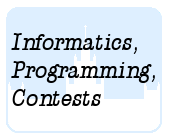Подразделы
Другие разделы
| Тренировка 1 |
| Тренировка 3 |
| Тренировка 4 |
| Тренировка 5 |
Дата и время
05/01/2026 09:32:59
 Тренировка 2
Тренировка 2
A. Phone List B. Cuckoo Hashing C.Optimal Parking D. Copying DNA E. Circle of Debt F. Full Tank? G. Nested Dolls H. Shopaholic I. Moogle
 H. Shopaholic
H. Shopaholic
 Быстрая сортировка
Быстрая сортировкаОлимпиадные задачи на английском языке

| 04/02/2008 | Зима 2008 дорешивание (2H) |
| 05/02/2008 | Тренировка (задачи Nordic CPC 2007) (H) |
| 15/11/2008 | Занятие 8 (G) |
Ограничения: время – 1s/2s, память – 64MiB Ввод: input.txt или стандартный ввод Вывод: output.txt или стандартный вывод 
Послать решение Blockly Посылки Темы Где Обсудить (0)

Lindsay is a shopaholic. Whenever there is
a discount of the kind where you can buy
three items and only pay for two, she goes
completely mad and feels a need to buy all
items in the store. You have given up on
curing her for this disease, but try to limit
its effect on her wallet.
You have realized that the stores coming with these offers are quite selective when it
comes to which items you get for free; it is always the cheapest ones. As an example,
when your friend comes to the counter with seven items, costing 400, 350, 300, 250, 200,
150, and 100 dollars, she will have to pay 1500 dollars. In this case she got a discount
of 250 dollars. You realize that if she goes to the counter three times, she might get a
bigger discount. E.g. if she goes with the items that costs 400, 300 and 250, she will get a
discount of 250 the first round. The next round she brings the item that costs 150 giving
no extra discount, but the third round she takes the last items that costs 350, 200 and
100 giving a discount of an additional 100 dollars, adding up to a total discount of 350.
Your job is to find the maximum discount Lindsay can get.
Input specifications
The first line of input gives the number of test scenarios, `1\ ≤\ t\ ≤\ 20`. Each scenario
consists of two lines of input. The first gives the number of items Lindsay is buying,
`1\ ≤\ n\ ≤\ 20000`. The next line gives the prices of these items, `1\ ≤\ p_i\ ≤\ 20000`.
Output specifications
For each scenario, output one line giving the maximum discount Lindsay can get by
selectively choosing which items she brings to the counter at the same time.
Sample input
1 6 400 100 200 350 300 250
Output for sample input
400

 Начало
Начало